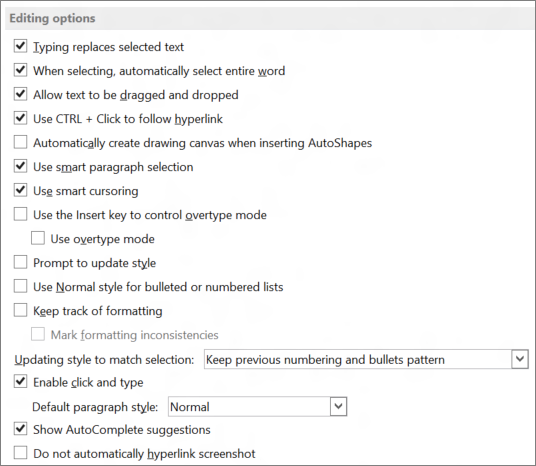

- Change order of styles in microsoft word for mac 2013 plus#
- Change order of styles in microsoft word for mac 2013 windows#
There are tools in Word that help visually decorate and enhance a document, while still optimizing accessibility.

Change order of styles in microsoft word for mac 2013 plus#
Use the list tool instead of the bullet character plus text.For example a link saying “Readings for Feb 14” is clearer than “Click here” for the Feb 14 readings. For links, avoid using link text such as “Here” or “Click for more.” Instead make sure link destinations are clear outside the context.For very complex tables, a table ALT tag can be used to add extra information for screen readers (see Quickstart Guides above for details). When inserting a data table, make sure the first row/column is marked as a header and includes a description of the type of data used in each row or column.See details in the Quickstart Guides above. For long documents, insert or generate a table of contents based on Heading 1, Heading 2, Heading 3 styles.Ensure that all documents use semantic heading styles.When inserting images or charts, be sure to add ALT tags or a description of the image for screenreaders.Know any other great Word tricks? Tell us about them on Twitter.Some content on this site based on material from Michigan State Web Accessibility and used with their permission. Next time you find yourself struggling with stubborn formatting or misplaced links, try using these tips to uncover the problem. Rhonda recommends always shading fields, but you can also opt to shade them only when they are selected. To make fields visible, open Preferences, then click “View” and select your preference for field shading. Entering text manually into these fields stops them from functioning correctly, so it’s important to be able to distinguish them from normal text. These features look like normal text, but they are actually fields that Word fills in according to a set pattern. Word has a few special features to help automate tasks like numbering pages and figures or creating a table of contents. This will put gray brackets around any bookmarked text. To show bookmarks in your document, open Preferences, then click “View” and check the bookmark box. Bookmarksīookmarks are useful for creating links within a document or between multiple documents. You can return to the standard view by clicking “Print Layout” on the far left of the View ribbon. All of your paragraphs should now have style names listed next to them. Use the View ribbon to switch to Draft view. Close the Preferences window and go back to the ribbon. Click “View” and find the preference for “style area width.” Increase the width to at least an inch (you can adjust it later if you want to change the size). If you would rather see the style names next to each paragraph, open the Preferences window from the main menu. The labels will appear next to each style in the Style Pane and in the left margin next to each paragraph that uses the style. This will randomly assign a number and color as a label for each style. At the bottom of the Styles Pane, check the box to show styles guides. The simple way is to open the Styles Pane using the button on the far right of the Home ribbon. To turn these marks on and off, click the pilcrow icon (¶) on the Home ribbon or use the keyboard shortcut, ⌘ + 8. You can learn more about formatting marks, including what each symbol means, in the CyberText Newsletter. With visible formatting marks, you can tell what is happening in your document at a glance. For example, uneven paragraph spacing could be caused by soft line breaks, section breaks or a style applied to a paragraph. Formatting marksįormatting marks may look like clutter if you aren’t used to them, but they hold a lot of useful information. All of the options for showing formatting and styles will only show up on your screen-they will not affect the printed version of a document. The instructions below are for Microsoft Word for Mac, version 16. The tips in this post are all ways to show hidden formatting in Word, which can help you diagnose problems when text doesn’t look right or won’t go where you want it to. So for all you other Mac users out there, here are a few translations.
Change order of styles in microsoft word for mac 2013 windows#
Unfortunately for me and my MacBook, CyberText’s tips are all written for Windows users. Her blog is a great resource for shortcuts, formatting tips and other useful features. One of my favorite sessions this year was presented by Rhonda Bracey of CyberText Consulting, who shared time-saving tips for Microsoft Word. I recently had the opportunity to attend the 22nd national conference of ACES: The Society for Editing.


 0 kommentar(er)
0 kommentar(er)
